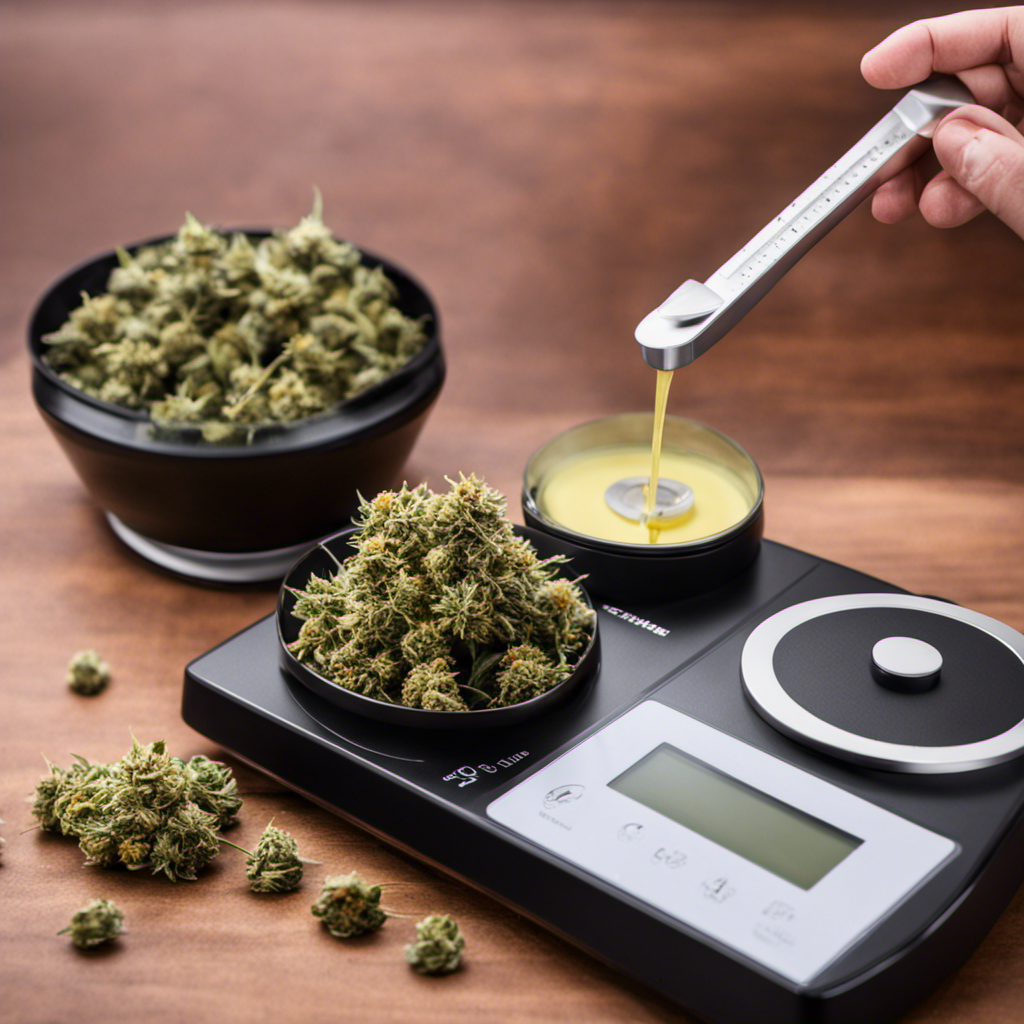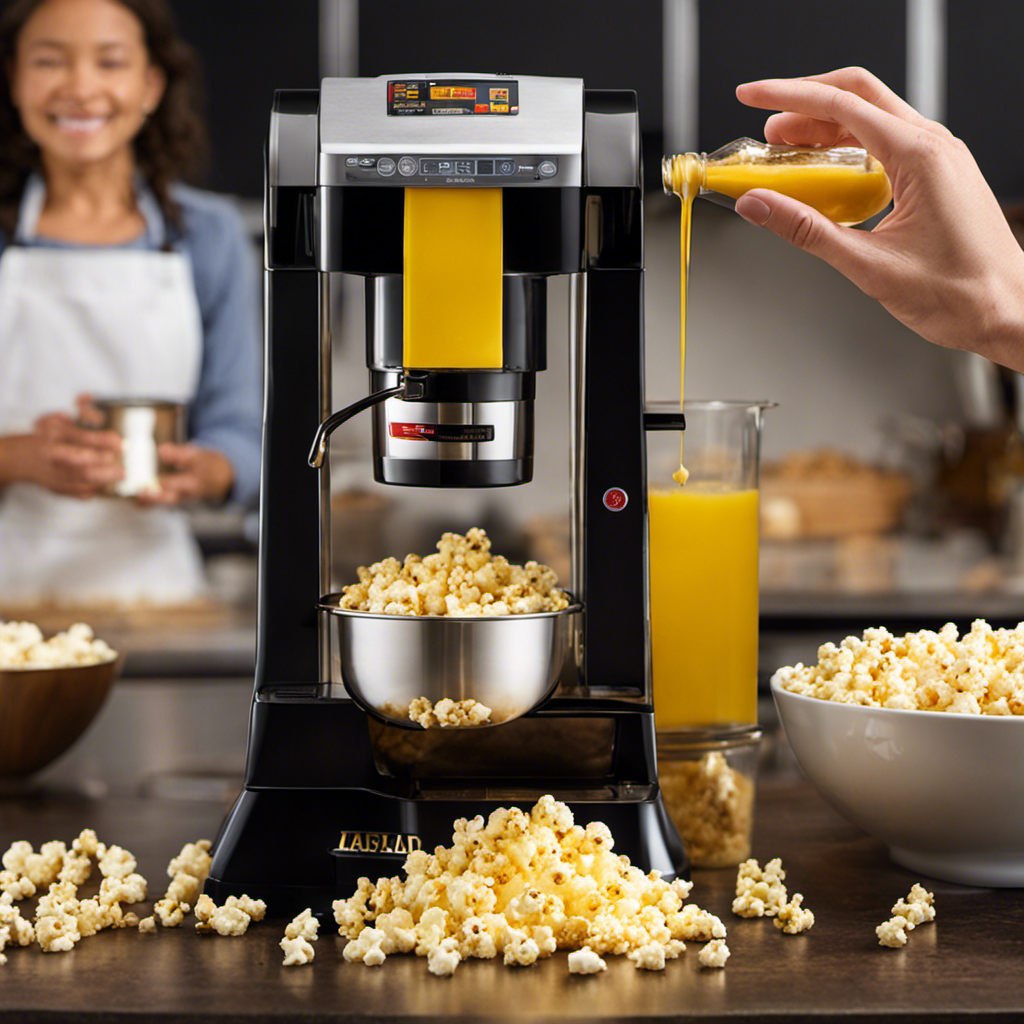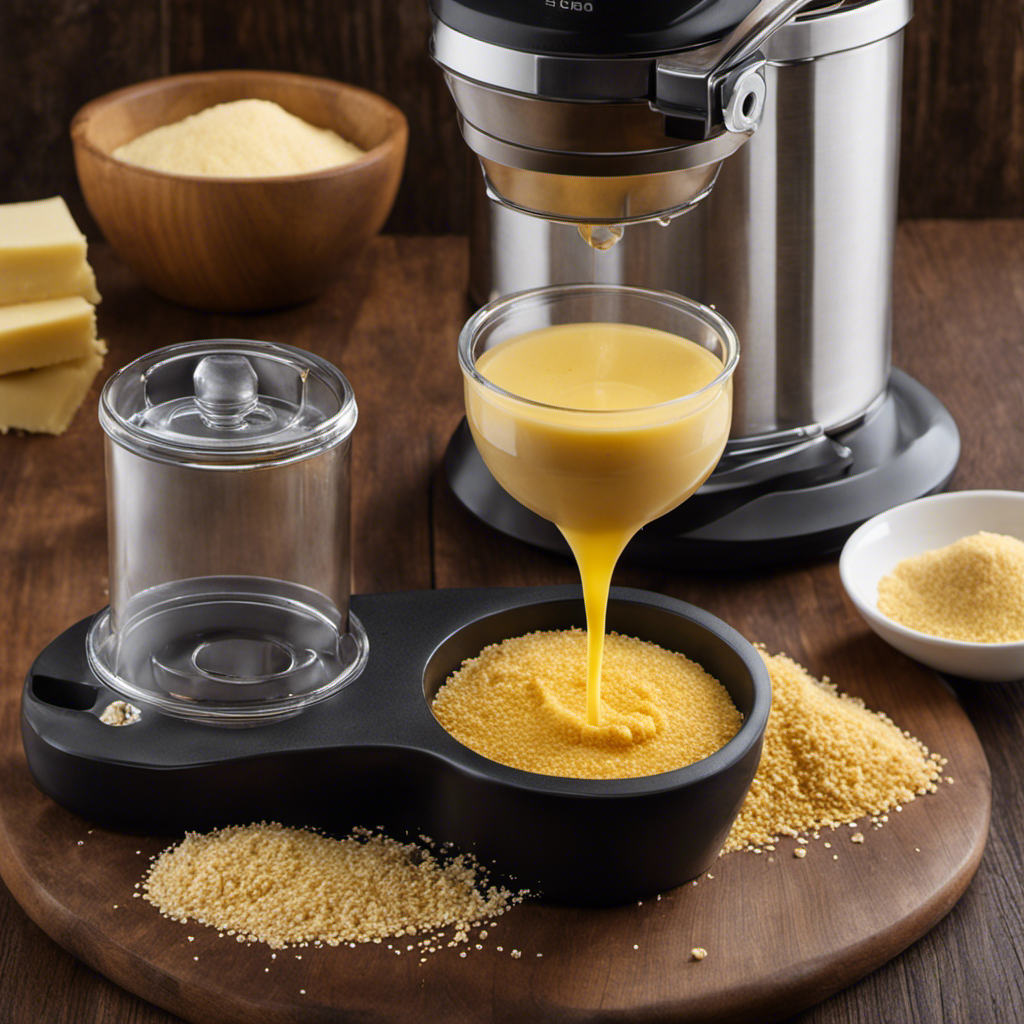I enjoy creating my own cannabis-infused butter, but achieving the perfect ratio of cannabis to butter can be a challenge.
That’s why I’m here to help you nail down the perfect amount of cannabis to make one stick of butter in your butter maker.
In this article, I’ll guide you through calculating the ideal quantity of cannabis, considering important factors, and provide a step-by-step guide to measuring it accurately.
Get ready to elevate your butter-making game!
Key Takeaways
- Using the right cannabis-to-butter ratio ensures desired potency
- Accuracy in calculating cannabis quantity is crucial for potency
- THC percentage of cannabis strain is needed for potency calculation
- Adjusting dosage is important for individual tolerance levels
Importance of Proper Cannabis-to-Butter Ratio
If you don’t use the proper cannabis-to-butter ratio, you may end up with a weak or overly potent batch of cannabutter. Calculating potency and adjusting dosage are crucial steps in ensuring that your cannabutter is just right.
To calculate potency, you need to know the THC percentage of your cannabis strain. This information can usually be found on the packaging or by researching online. Once you have the THC percentage, you can use a simple formula to determine the amount of THC in your cannabutter.
Adjusting dosage is important because everyone’s tolerance to cannabis is different. By starting with a small amount and gradually increasing, you can find the perfect dosage for your needs.
With the proper cannabis-to-butter ratio, you can create cannabutter that provides the desired effects and avoids any unpleasant surprises. Now let’s move on to calculating the ideal amount of cannabis.
Calculating the Ideal Amount of Cannabis
To calculate the ideal amount, simply determine how potent you want your butter to be and adjust the quantity accordingly.
Calculating accuracy is crucial in ensuring that your cannabis-infused butter turns out just the way you want it. The first step is to decide on the potency you desire. This will depend on your personal preferences and the intended use of the butter.
If you prefer a milder effect, you might want to use a smaller amount of cannabis. On the other hand, if you’re looking for a stronger potency, you can increase the quantity. It’s essential to consider your tolerance level and start with a lower dosage if you’re new to edibles.
Factors to Consider When Determining Cannabis Quantity
When it comes to making cannabis-infused butter, determining the ideal cannabis-to-butter ratio is crucial. This ratio will greatly affect the potency and dosage of the final product, so it’s important to get it right.
In this discussion, we will explore the factors to consider when determining the ideal cannabis quantity, including potency and dosage calculation.
Ideal Cannabis-To-Butter Ratio
You’ll want to aim for an ideal cannabis-to-butter ratio of about 1 ounce of cannabis per 1 pound of butter. This ratio ensures that the butter is infused with enough cannabis to provide the desired potency, while still maintaining a balanced flavor.
To calculate the cannabis potency, you’ll need to know the THC percentage of your cannabis strain. This information can usually be found on the packaging or obtained from the dispensary.
Adjusting the dosage preferences is also important, as it allows you to customize the strength of your infused butter. Some people prefer a milder effect, while others may want a more potent experience. By adjusting the amount of cannabis used, you can tailor the dosage to your liking.
With the ideal cannabis-to-butter ratio and adjusted dosage preferences, you can create infused butter that suits your needs perfectly.
Moving forward, let’s delve into the next section on potency and dosage calculation.
Potency and Dosage Calculation
For calculating the potency and dosage of your infused butter, it’s important to know the THC percentage of your cannabis strain. This information will help you determine the strength of your butter and how much to consume.
To calculate the potency, follow these steps:
- Determine the THC percentage of your cannabis strain. This can be found on the packaging or by researching online.
- Convert the THC percentage to milligrams. Multiply the percentage by the weight of your cannabis.
- Calculate the total milligrams of THC in your infused butter by multiplying the milligrams of THC by the amount of butter used.
- To determine the dosage, divide the total milligrams of THC in your infused butter by the number of servings.
It’s important to start with a low dosage and gradually increase as needed. Consult dosage guidelines and start with a small amount to gauge your tolerance.
Step-by-Step Guide to Measuring Cannabis for Butter Making
When it comes to making cannabis butter, two key factors to consider are the optimal cannabis butter ratio and accurate cannabis measurement.
The optimal ratio determines the potency and flavor of the butter, while accurate measurement ensures consistency in dosage and desired effects.
In this discussion, I will provide a step-by-step guide on how to achieve the perfect cannabis butter ratio and accurately measure your cannabis for butter making.
Optimal Cannabis Butter Ratio
To achieve the optimal cannabis butter ratio, mix a specific amount of cannabis with butter in the butter maker. This ratio is crucial for calculating cannabis potency and adjusting infusion strength. Here’s a step-by-step guide to help you achieve the perfect ratio:
-
Determine the desired potency: Consider the strength of your cannabis and the desired effect. Calculating the THC content will help you gauge the potency.
-
Adjust the infusion strength: If you want a stronger infusion, increase the amount of cannabis. For a milder infusion, reduce the amount.
-
Measure the cannabis: Grind the cannabis and measure it using a scale. Start with a recommended amount and adjust according to your desired potency.
-
Combine with butter: Melt the butter in the butter maker and add the measured cannabis. Stir well to ensure even distribution.
-
Infuse: Set the butter maker to the recommended temperature and time. This will allow the cannabinoids to infuse into the butter.
Accurate Cannabis Measurement
Measuring cannabis accurately is crucial for achieving the desired potency and infusion strength in your cannabis butter.
There are different methods of cannabis measurement that can be used to ensure accuracy. One common technique is using a digital scale to weigh the cannabis buds before adding them to the butter maker. This allows for precise measurements and helps in calculating the ratio of cannabis to butter.
Another method is using measuring cups to estimate the volume of ground cannabis. However, it is important to note that this method may not be as accurate as using a scale.
Additionally, using a tablespoon or teaspoon to measure cannabis can be a convenient option, but it may not provide the same level of accuracy as using a scale.
Ultimately, choosing the right measurement technique is crucial for achieving consistent results in your cannabis butter.
Tips for Adjusting Cannabis Amount for Personal Preferences
If you want to customize the potency of your cannabis-infused butter, you can adjust the amount of cannabis used according to your personal preferences. Experimenting with dosage is key to finding the perfect balance for your desired effects.
Here are some tips for adjusting the cannabis amount:
-
Start low and go slow:
-
Begin with a small amount of cannabis and gradually increase it in future batches to find your ideal potency level.
-
This approach allows you to gauge the effects and make adjustments accordingly.
-
Consider strain potency:
-
Different cannabis strains have varying levels of THC and CBD.
-
Choose a strain with the desired potency to achieve the desired effects in your butter.
Common Mistakes to Avoid in Determining Cannabis Quantity
When determining the quantity of cannabis for your infused butter, be mindful of these common mistakes to ensure a successful outcome. It’s important to have a clear understanding of how much cannabis you should use to achieve your desired potency. One common misconception is that more cannabis will always result in a stronger infusion, but this is not necessarily true. Using too much cannabis can actually overpower the flavor of the butter and make it unpleasant to consume. On the other hand, using too little cannabis may not give you the desired effects. It’s all about finding the right balance. To help you with this, here is a table outlining some discussion ideas and common misconceptions when it comes to determining the quantity of cannabis for your infused butter:
| Discussion Ideas | Common Misconceptions |
|---|---|
| Start low and go slow | More cannabis means stronger infusion |
| Consider tolerance levels | Using too little cannabis won’t give desired effects |
| Experiment with different strains | Using too much cannabis can overpower the flavor |
| Keep track of dosage | Cannabis potency is consistent |
Conclusion
In conclusion, finding the right cannabis-to-butter ratio is crucial for achieving the desired potency in your homemade butter. By carefully calculating the ideal amount of cannabis and considering factors such as strain potency and personal preferences, you can ensure a successful butter-making process.
Remember to follow the step-by-step guide and avoid common mistakes to achieve the best results. Just like a master chef carefully measures ingredients to create a masterpiece, mastering the art of cannabis-infused butter will leave you feeling satisfied and euphoric.










